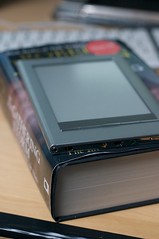Sony Reader Touch.
Last year, I posted a bit about the attraction of ebook readers. About six weeks after that post, my birthday brought me a Sony Reader Touch. I’ve been living with it and using it every day since then.
To recap, the things I want from an ebook reader:
- Good for reading fiction, and good availability of genre fiction in the right format.
- Good PDF performance for reading technical books.
- Solid device functionality.
I am, on the whole, very happy with my Reader. I spend a lot of time with it in my hands, and it does its job well, if imperfectly.
Physically, it’s an attractive, solidly built device. One of the attractions of an ebook reader is that it can make an 800 page book sit comfortably in one hand. For comparison, and a little irony, here’s my Reader sitting on top of a Monstrously Huge Fantasy Book that I bought on the same day:
I find the battery life to be well short of the advertised 7000 page turns, but I comfortably go a week and a half between charges. Charging is over USB, and unfortunately you can’t use it to read while it’s charging.
The display is the Touch’s strength and its weakness. eInk is good, and very comfortable to read. It’s nice and crisp and easy on the eyes, yet the touch sensitive layer on the Reader Touch is quite reflective, which adds some glare and reduces the contrast compared to other readers on the market which use the same display. This means you have to be aware of what angle you hold it at when reading.
That’s a problem, but one which I don’t find to be a big deal, and which for me was well-balanced by the functionality of the device.
To my criteria above, then.
For fiction, an attraction of the Reader Touch was the breadth of formats it can handle, the most important of which is ePub. You can get ePubs all over the web, including from Waterstones. It’s also a nice easy format to work with, and conversion tools from other formats are readily available. Many of the ePubs you can buy are encrypted using Adobe’s Digital Editions DRM system. DRM’s a pain, and largely evil, but ADE is a fairly painless and user-friendly system. The Reader supports it for ePub and for PDF. This means that while I haven’t been able to find everything I’ve wanted to read in an electronic format, much is available.
For technical books, the PDF support is pretty good. At the time it was the best option in the UK, although Amazon have just released the international version of the Kindle DX. I still have my eye on that. The Reader can reflow many PDFs to fit the screen, but you lose diagrams and layout (important for code examples). If you turn it to landscape mode, it can show half a page at a time of most technical PDFs. This is usable and readable, but not stellar. It’s also pretty much the state of the market, unfortunately. There are, however, a few forward-thinking publishers (like the Pragmatic Programmers) who publish ePubs. They’re great. More of that, please.
The Reader handles a wide range of formats, well. The touch interface isn’t necessary, and could maybe be traded for a higher contrast display if it wasn’t at the expense of format support, but it does make sifting through your library very handy. I still like the hardware buttons for page turns, though.
I’ve been looking at ebook readers for a few years, and it’s only now that there are a couple available that I would actually consider buying. At the time I bought the Touch, it was the best option for me that was available in the UK. The technology is still maturing, and the devices are still getting better. The Kindles are compelling, Barnes & Noble’s Nook looks interesting, and there’s a rumour that Apple will be announcing something relevant this evening.
For what it is, though, I’m impressed and content with my Reader, and I manage to use it comfortably every day. That’ll do for now.
